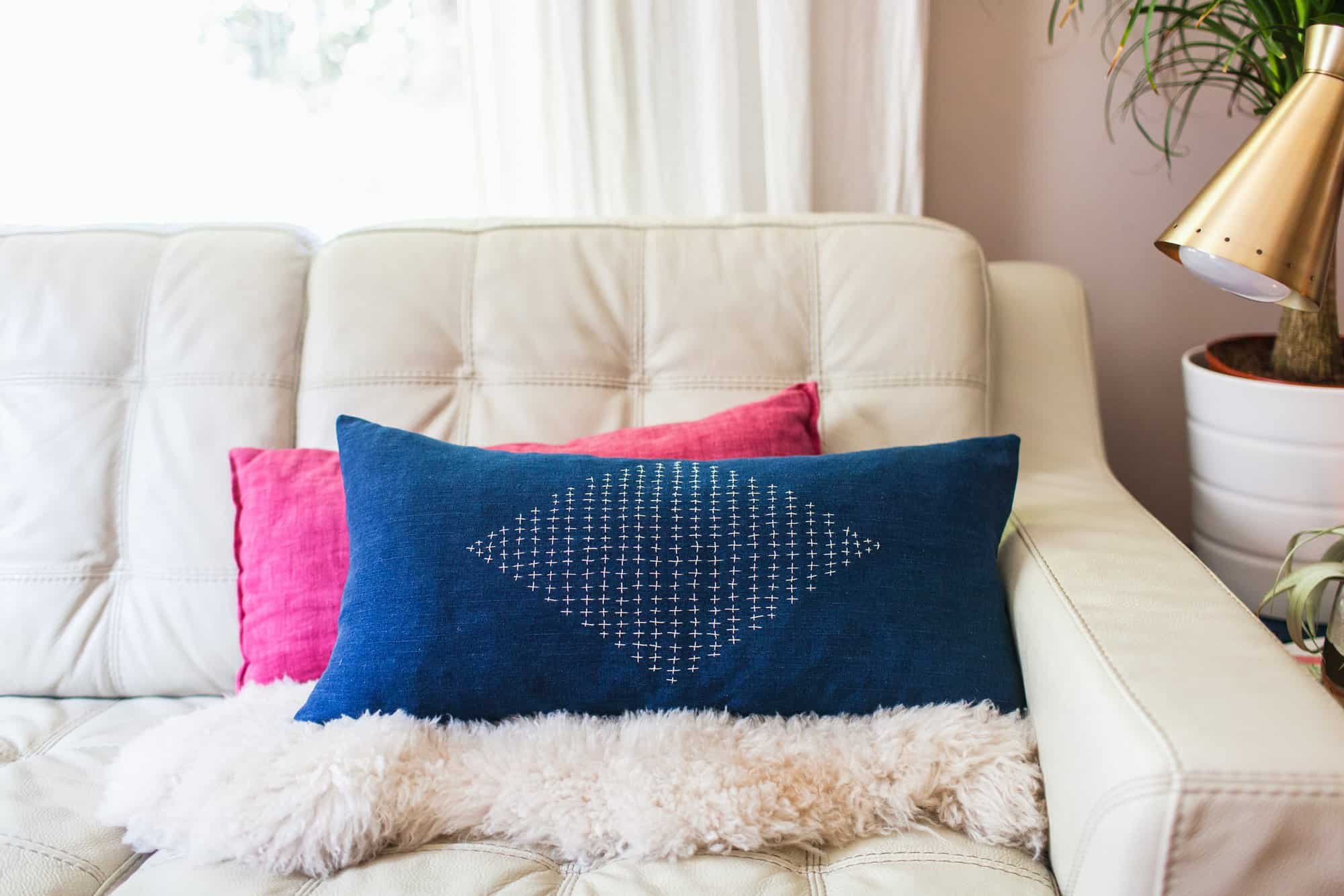 Sashiko is a Japanese hand-stitching technique that translates to mean “little stabs” and is an age old way to reinforce worn fabric with decorative stitching. It’s another ancient tradition that’s showing up in maker’s circles as part of the slow fashion movement. Patterns can vary from densely stitched waves, repeating diamonds, and linked squares to simple parallel lines made of running stitches. While I am intrigued by the more intricate designs, I thought I’d start with something simple and turned some leftover denim into a Sashiko-style bolster pillow. The project was pretty easy and you don’t have to be really great at embroidery for this to look good, thanks to the magic of tailor’s chalk!
Sashiko is a Japanese hand-stitching technique that translates to mean “little stabs” and is an age old way to reinforce worn fabric with decorative stitching. It’s another ancient tradition that’s showing up in maker’s circles as part of the slow fashion movement. Patterns can vary from densely stitched waves, repeating diamonds, and linked squares to simple parallel lines made of running stitches. While I am intrigued by the more intricate designs, I thought I’d start with something simple and turned some leftover denim into a Sashiko-style bolster pillow. The project was pretty easy and you don’t have to be really great at embroidery for this to look good, thanks to the magic of tailor’s chalk!
For this project, I upcycled a pair of wide leg jeans that I had cut off to wear as summer shorts, but the excess denim was so wide and the denim was such good quality, I knew I might be able to use them in the future. Hoarding gone right? Hmmm … maybe that’s still pushing it. I didn’t have a thimble on hand, but it does help to use one when you’re working with such tiny stitches.


 Supplies
Supplies
-sturdy denim or dyed cotton canvas measuring 24″ x 24″. Avoid using stretch denim.
-12″ embroidery hoop
-cotton embroidery thread
-embroidery needle
-Poly-Fil or similar stuffing
-cutting mat
-acrylic ruler
-rotary cutter
-thimble
-tailor’s chalk
-scissors
-sewing machine
 Use your rotary cutter, acrylic ruler, and cutting mat to cut your denim so that you have two pieces that measure about 12″ x 24″.
Use your rotary cutter, acrylic ruler, and cutting mat to cut your denim so that you have two pieces that measure about 12″ x 24″. Set one rectangle aside and then find the center of the other rectangle. Mark it with your tailor’s chalk. Then measure 5″ above and 5″ below and draw a straight line with your chalk. Find that center mark again and measure out 7″ to the left and 7″ to the right. Mark a straight line with your chalk. Then connect the points with four more lines to create a diamond shape as shown.
Set one rectangle aside and then find the center of the other rectangle. Mark it with your tailor’s chalk. Then measure 5″ above and 5″ below and draw a straight line with your chalk. Find that center mark again and measure out 7″ to the left and 7″ to the right. Mark a straight line with your chalk. Then connect the points with four more lines to create a diamond shape as shown.
 Measure about 1/2″ from your center vertical line and draw another vertical line. Continue measuring and drawing on either side about 1/2″ apart. This will all get washed off at a later step, but makes it so much easier to stitch straight lines. Then put your fabric in your embroidery hoop so that it’s mostly centered. If you’re using a smaller hoop, you can just adjust it as you go.
Measure about 1/2″ from your center vertical line and draw another vertical line. Continue measuring and drawing on either side about 1/2″ apart. This will all get washed off at a later step, but makes it so much easier to stitch straight lines. Then put your fabric in your embroidery hoop so that it’s mostly centered. If you’re using a smaller hoop, you can just adjust it as you go.
 The rest is simple. Start with a 3′ length of thread with a large knot at the end. Thread your needle so that you have a 6″ tail and start from the back of the hoop. Stitch 4-5 short lines that are as close together as you can manage. It helps to stitch these all at the same time before pulling your thread through for the most consistently straight lines.
The rest is simple. Start with a 3′ length of thread with a large knot at the end. Thread your needle so that you have a 6″ tail and start from the back of the hoop. Stitch 4-5 short lines that are as close together as you can manage. It helps to stitch these all at the same time before pulling your thread through for the most consistently straight lines.
 Follow your vertical lines and then stitch your horizontal lines so that they cross over your vertical lines. I didn’t stitch along my perimeter because I wanted the crosses to create the diamond shape themselves.
Follow your vertical lines and then stitch your horizontal lines so that they cross over your vertical lines. I didn’t stitch along my perimeter because I wanted the crosses to create the diamond shape themselves.
 This is what mine looked like when I finished. I added more thread as I ran out, always tying a double knot at the beginning and end of each length and starting from the back side. Remove your hoop and adjust your denim if you need to.
This is what mine looked like when I finished. I added more thread as I ran out, always tying a double knot at the beginning and end of each length and starting from the back side. Remove your hoop and adjust your denim if you need to.
To get rid of the chalk lines, run your fabric under running water and let it air dry.
 Place your two sides of fabric together with the right sides facing each other and pin around the edges every 4″ or so. Use your sewing machine and stitch almost all of the way around the perimeter of your pinned fabric except for a space of 5″. Back stitch at the start and end of this space. Remove your pins after stitching the two pieces together and use the 5″ opening to turn your fabric right side out. Fill with stuffing and then hand-stitch your opening closed using a blind stitch.
Place your two sides of fabric together with the right sides facing each other and pin around the edges every 4″ or so. Use your sewing machine and stitch almost all of the way around the perimeter of your pinned fabric except for a space of 5″. Back stitch at the start and end of this space. Remove your pins after stitching the two pieces together and use the 5″ opening to turn your fabric right side out. Fill with stuffing and then hand-stitch your opening closed using a blind stitch.


 Fluff your new pillow and enjoy your new handiwork!
Fluff your new pillow and enjoy your new handiwork!
Interested in learning more about Sashiko? Check out @katrinarodabaugh‘s work or The Ultimate Sashiko Sourcebook by Susan Briscoe. –Rachel




22 Comments
I love the look but I don’t know if I would have the patience to make all those lines of stitches!!
xo
Phyllis
http://desgeulasse.com/
This is such a great way of reusing old jeans! I wish I didn’t just throw out a few pairs…
Charmaine Ng | Architecture & Lifestyle Blog
http://charmainenyw.com
Great DIY! You guys always have the cutest ideas <3
https://www.myblackcloset.com/
This is beautiful, Rachel! I appreciate the snippet of background information on the traditional stitching.
It’s cool to see denim worked into home decor…it would be interesting to see a weaving project incorporating denim scraps possibly!
It’s beautiful, I want to make one too!
I love it!
Like you say the embroidery itself is not too complicated so this is an ideal project for anyone looking for a simple pattern. I also love the idea of re-using old denim to make embroidered pillows! Nothing goes to waste 🙂
xx,
Catia
http://www.thepetitecat.com
The stitches look so delicate, beautiful!
https://www.makeandmess.com/
It looks rather easy to make, but knowing me, it would be a true nightmare 🙂
How interesting that different parts of the world come up with similar techniques. No clue if one influenced the other, but your beautiful Shashiko cushion cover reminds me of the ‘Kantha’ stitch from the Indian sub-continent, which uses the basic running stitch to create patterns from simple lines to extremely elaborate sceneries… here’s what Wikipedia says – https://en.wikipedia.org/wiki/Kantha
So interesting when you discover such unlikely similarities, right?!
Heart eyes all around!
This pillow is perfection! I love it!
Paige
http://thehappyflammily.com
What is that lovely wall color? A type of pale pink? Gorgeous! The pillow really pops against it!
Ooh, I really like the simplicity of this and how it combines old and new! Great job!!
This looks beautiful, Rachel! I have some busier indigo pillows that this would pair so well with. It’s nice that it’s simple, but still has detail.
Amanda
rayaexchange.com
Great post,I love their ideas
I’ve been scouting for a large pillow for my bed that’d be affordable. This looks absolutely perfect. Now to pick out a background color.
Great to know about the Sashiko hand stitching technique, the pillow is really looking wonderful. Thanks for sharing such amazing idea.
This reminds me directly of Kintsugi – another Japanese art which works with broken bowls and utensils but makes them look so much prettier – it’s amazing what the Japanese can do with things that are old or broken!
Goodness, that is gorgeous! Definitely added to my inspiration pins!
3D Puff Embroidery Digitizing
Thank you for a great explanation. I was looking online for a similar idea and really appreciate it
This blog is amazing, and great EMBROIDERED PILLOW . I appreciate this Post,
Thanks for your share.
Hi RACHELE,
Your embroidered Pillow looks simple but beautiful, I Love Your idea to make embroidered pillows! Keep the good work.